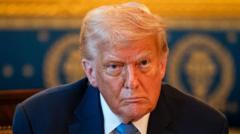In a dramatic escalation, U.S. President Donald Trump has reignited international trade tensions with his latest announcement of tariffs affecting multiple Asian nations, particularly Japan. Prime Minister Shigeru Ishiba of Japan characterized this development as "deeply regrettable," especially given Japan's efforts to soothe negotiations and protect its car manufacturers from a proposed 25% duty while resisting American pressure to import rice.
Japan is now among 23 countries—including 14 in Asia—that received tariff advisories as the U.S. seeks to reshape its trade agreements. Despite Japan's frequent diplomatic visits to Washington, progress has stalled, prompting concerns about the looming tariffs which threaten even stout allies.
On the latest front, the U.S. has issued an increase in tariffs for various partners, notably raising obligations for imported Canadian goods to 35%, while hinting at a blanket tariff enhancement from 10% to as high as 20%. Trump emphasized there would be no exceptions as countries scramble to negotiate alternative terms before the cutoff date at the end of the month.
The deadline extension may paradoxically benefit some nations, offering them additional time to negotiate and formulate responses to U.S. demands. Economists suggest that countries like Thailand and Malaysia, which recently received tariff notifications, will be keen to engage proactively in negotiations, particularly as the U.S. targets Chinese exports that transship through other countries—an increasingly complex aspect of international trade.
However, the broader repercussions of Trump's tariffs appear daunting for many Asian manufacturers who thrive on exports. Reports highlight a potential downturn for companies reliant on global supply chains, as U.S. importers and consumers could suffer from inflated prices due to these tariffs. Although the international trading system remains intricately connected, some nations will feel the economic strain more acutely than others. Countries like Vietnam and Cambodia, which have already begun facing substantial tariffs, may find themselves with minimal leverage in negotiations.
While South Korea and Japan, with their greater resources, may be able to extend their negotiation strategies, countries such as India await clarity on their own trade standing, which has thus far escaped tariff letters. Delays fueled by ongoing discussions about market access and agricultural imports have contributed to uncertainty around future agreements.
The relationship between the U.S. and Japan may experience a paradigm shift due to Trump's approach, as analysts note that Japan's willingness to stand firm on various issues may lead towards a recalibration of its long-term coalition with the U.S.
In the grander scheme of geopolitical relations, Asia finds itself at the crossroads of U.S.-China tensions, with many questioning whether America's extended tariffs may inadvertently strengthen China's position as a more stable partner in contrast to the unpredictability of U.S. trade policies.
As conversations unfold, it raises the question of which nation, the U.S. or China, will come out with increased influence in the region amidst the uncertainty. The process of untangling these tariffs promises to be complex and lengthy, prompting both sides to prepare for a drawn-out negotiation that may stretch for years.





















